Three-amino acid spacing of presenilin endoproteolysis suggests a general stepwise cleavage of gamma-secretase-mediated intramembrane proteolysis
- PMID: 20534834
- PMCID: PMC6632680
- DOI: 10.1523/JNEUROSCI.1443-10.2010
Three-amino acid spacing of presenilin endoproteolysis suggests a general stepwise cleavage of gamma-secretase-mediated intramembrane proteolysis
Abstract
Presenilin (PS1 or PS2) is the catalytic component of the gamma-secretase complex, which mediates the final proteolytic processing step leading to the Alzheimer's disease (AD)-characterizing amyloid beta-peptide. PS is cleaved during complex assembly into its characteristic N- and C-terminal fragments. Both fragments are integral components of physiologically active gamma-secretase and harbor the two critical aspartyl residues of the active site domain. While the minimal subunit composition of gamma-secretase has been defined and numerous substrates were identified, the cellular mechanism of the endoproteolytic cleavage of PS is still unclear. We addressed this pivotal question by investigating whether familial AD (FAD)-associated PS1 mutations affect the precision of PS endoproteolysis in a manner similar to the way that such mutations shift the intramembrane cleavage of gamma-secretase substrates. We demonstrate that all FAD mutations investigated still allow endoproteolysis to occur. However, the precision of PS1 endoproteolysis is affected by PS1 mutations. Comparing the cleavage products generated by a variety of PS1 mutants revealed that specifically cleavages at positions 293 and 296 of PS1 are selectively affected. Systematic mutagenesis around the cleavage sites revealed a stepwise three amino acid spaced cleavage mechanism of PS endoproteolysis reminiscent to the epsilon-, zeta-, and gamma-cleavages described for typical gamma-secretase substrates, such as the beta-amyloid precursor protein. Our findings therefore suggest that intramembranous cleavage by gamma-secretase and related intramembrane-cleaving proteases may generally occur via stepwise endoproteolysis.
Figures
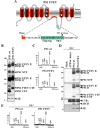


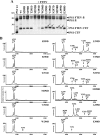
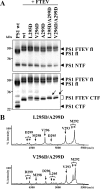
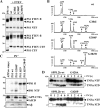
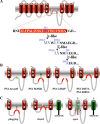
Similar articles
-
Different transmembrane domains determine the specificity and efficiency of the cleavage activity of the γ-secretase subunit presenilin.J Biol Chem. 2023 May;299(5):104626. doi: 10.1016/j.jbc.2023.104626. Epub 2023 Mar 20. J Biol Chem. 2023. PMID: 36944398 Free PMC article.
-
Mutation analysis of the presenilin 1 N-terminal domain reveals a broad spectrum of gamma-secretase activity toward amyloid precursor protein and other substrates.J Biol Chem. 2010 Dec 3;285(49):38042-52. doi: 10.1074/jbc.M110.132613. Epub 2010 Oct 4. J Biol Chem. 2010. PMID: 20921220 Free PMC article.
-
Requirement for small side chain residues within the GxGD-motif of presenilin for gamma-secretase substrate cleavage.J Neurochem. 2010 Feb;112(4):940-50. doi: 10.1111/j.1471-4159.2009.06510.x. Epub 2009 Dec 15. J Neurochem. 2010. PMID: 20021564
-
Genes and mechanisms involved in beta-amyloid generation and Alzheimer's disease.Eur Arch Psychiatry Clin Neurosci. 1999;249(6):266-70. doi: 10.1007/s004060050098. Eur Arch Psychiatry Clin Neurosci. 1999. PMID: 10653281 Review.
-
Toward the structure of presenilin/γ-secretase and presenilin homologs.Biochim Biophys Acta. 2013 Dec;1828(12):2886-97. doi: 10.1016/j.bbamem.2013.04.015. Biochim Biophys Acta. 2013. PMID: 24099007 Free PMC article. Review.
Cited by
-
γ-Secretase-Dependent Proteolysis of Transmembrane Domain of Amyloid Precursor Protein: Successive Tri- and Tetrapeptide Release in Amyloid β-Protein Production.Int J Alzheimers Dis. 2012;2012:591392. doi: 10.1155/2012/591392. Epub 2012 Dec 31. Int J Alzheimers Dis. 2012. PMID: 23346458 Free PMC article.
-
Presenilin transmembrane domain 8 conserved AXXXAXXXG motifs are required for the activity of the γ-secretase complex.J Biol Chem. 2015 Mar 13;290(11):7169-84. doi: 10.1074/jbc.M114.601286. Epub 2015 Jan 22. J Biol Chem. 2015. PMID: 25614624 Free PMC article.
-
Different transmembrane domains determine the specificity and efficiency of the cleavage activity of the γ-secretase subunit presenilin.J Biol Chem. 2023 May;299(5):104626. doi: 10.1016/j.jbc.2023.104626. Epub 2023 Mar 20. J Biol Chem. 2023. PMID: 36944398 Free PMC article.
-
Efficient production of a mature and functional gamma secretase protease.Sci Rep. 2018 Aug 27;8(1):12834. doi: 10.1038/s41598-018-30788-w. Sci Rep. 2018. PMID: 30150752 Free PMC article.
-
Lysine 624 of the amyloid precursor protein (APP) is a critical determinant of amyloid β peptide length: support for a sequential model of γ-secretase intramembrane proteolysis and regulation by the amyloid β precursor protein (APP) juxtamembrane region.J Biol Chem. 2011 Nov 18;286(46):39804-12. doi: 10.1074/jbc.M111.274696. Epub 2011 Aug 25. J Biol Chem. 2011. PMID: 21868378 Free PMC article.
References
-
- Beher D, Wrigley JD, Nadin A, Evin G, Masters CL, Harrison T, Castro JL, Shearman MS. Pharmacological knock-down of the presenilin 1 heterodimer by a novel γ-secretase inhibitor: implications for presenilin biology. J Biol Chem. 2001;276:45394–45402. - PubMed
-
- Campbell WA, Iskandar MK, Reed ML, Xia W. Endoproteolysis of presenilin in vitro: inhibition by gamma-secretase inhibitors. Biochemistry. 2002;41:3372–3379. - PubMed
-
- Campbell WA, Reed ML, Strahle J, Wolfe MS, Xia W. Presenilin endoproteolysis mediated by an aspartyl protease activity pharmacologically distinct from gamma-secretase. J Neurochem. 2003;85:1563–1574. - PubMed
-
- Capell A, Saffrich R, Olivo JC, Meyn L, Walter J, Grünberg J, Mathews P, Nixon R, Dotti C, Haass C. Cellular expression and proteolytic processing of presenilin proteins is developmentally regulated during neuronal differentiation. J Neurochem. 1997;69:2432–2440. - PubMed
-
- Capell A, Grünberg J, Pesold B, Diehlmann A, Citron M, Nixon R, Beyreuther K, Selkoe DJ, Haass C. The proteolytic fragments of the Alzheimer's disease-associated presenilin-1 form heterodimers and occur as a 100–150-kDa molecular mass complex. J Biol Chem. 1998;273:3205–3211. - PubMed
Publication types
MeSH terms
Substances
LinkOut - more resources
Full Text Sources
Medical
